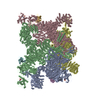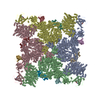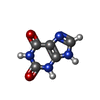+ データを開く
データを開く
- 基本情報
基本情報
| 登録情報 | データベース: PDB / ID: 7ua4 | |||||||||
|---|---|---|---|---|---|---|---|---|---|---|
| タイトル | Structure of PKA phosphorylated human RyR2-R2474S in the open state in the presence of Calmodulin | |||||||||
 要素 要素 |
| |||||||||
 キーワード キーワード | MEMBRANE PROTEIN / Ryanodine receptor 2 / calcium channel | |||||||||
| 機能・相同性 |  機能・相同性情報 機能・相同性情報junctional sarcoplasmic reticulum membrane / sarcoplasmic reticulum calcium ion transport / establishment of protein localization to endoplasmic reticulum / type B pancreatic cell apoptotic process / Purkinje myocyte to ventricular cardiac muscle cell signaling / calcium-induced calcium release activity / regulation of atrial cardiac muscle cell action potential / left ventricular cardiac muscle tissue morphogenesis / suramin binding / regulation of AV node cell action potential ...junctional sarcoplasmic reticulum membrane / sarcoplasmic reticulum calcium ion transport / establishment of protein localization to endoplasmic reticulum / type B pancreatic cell apoptotic process / Purkinje myocyte to ventricular cardiac muscle cell signaling / calcium-induced calcium release activity / regulation of atrial cardiac muscle cell action potential / left ventricular cardiac muscle tissue morphogenesis / suramin binding / regulation of AV node cell action potential / regulation of SA node cell action potential / cell communication by electrical coupling involved in cardiac conduction / regulation of ventricular cardiac muscle cell action potential / ventricular cardiac muscle cell action potential / positive regulation of sequestering of calcium ion / negative regulation of calcium-mediated signaling / embryonic heart tube morphogenesis / cardiac muscle hypertrophy / negative regulation of insulin secretion involved in cellular response to glucose stimulus / neuronal action potential propagation / negative regulation of release of sequestered calcium ion into cytosol / insulin secretion involved in cellular response to glucose stimulus / calcium ion transport into cytosol / ryanodine-sensitive calcium-release channel activity / CaM pathway / Cam-PDE 1 activation / Sodium/Calcium exchangers / response to caffeine / regulation of cardiac muscle contraction by calcium ion signaling / release of sequestered calcium ion into cytosol by sarcoplasmic reticulum / Calmodulin induced events / response to redox state / positive regulation of ryanodine-sensitive calcium-release channel activity / Reduction of cytosolic Ca++ levels / Activation of Ca-permeable Kainate Receptor / CREB1 phosphorylation through the activation of CaMKII/CaMKK/CaMKIV cascasde / Loss of phosphorylation of MECP2 at T308 / 'de novo' protein folding / CREB1 phosphorylation through the activation of Adenylate Cyclase / CaMK IV-mediated phosphorylation of CREB / PKA activation / negative regulation of high voltage-gated calcium channel activity / negative regulation of heart rate / Glycogen breakdown (glycogenolysis) / CLEC7A (Dectin-1) induces NFAT activation / Activation of RAC1 downstream of NMDARs / organelle localization by membrane tethering / negative regulation of ryanodine-sensitive calcium-release channel activity / mitochondrion-endoplasmic reticulum membrane tethering / autophagosome membrane docking / FK506 binding / negative regulation of calcium ion export across plasma membrane / regulation of cardiac muscle cell action potential / presynaptic endocytosis / protein kinase A regulatory subunit binding / response to muscle activity / Synthesis of IP3 and IP4 in the cytosol / regulation of cell communication by electrical coupling involved in cardiac conduction / protein kinase A catalytic subunit binding / Phase 0 - rapid depolarisation / calcineurin-mediated signaling / Negative regulation of NMDA receptor-mediated neuronal transmission / positive regulation of the force of heart contraction / Unblocking of NMDA receptors, glutamate binding and activation / cellular response to caffeine / RHO GTPases activate PAKs / intracellularly gated calcium channel activity / Ion transport by P-type ATPases / Uptake and function of anthrax toxins / regulation of ryanodine-sensitive calcium-release channel activity / Long-term potentiation / protein phosphatase activator activity / Calcineurin activates NFAT / Regulation of MECP2 expression and activity / smooth muscle contraction / DARPP-32 events / catalytic complex / Smooth Muscle Contraction / detection of calcium ion / regulation of cardiac muscle contraction / regulation of cytosolic calcium ion concentration / RHO GTPases activate IQGAPs / regulation of cardiac muscle contraction by regulation of the release of sequestered calcium ion / T cell proliferation / smooth endoplasmic reticulum / calcium channel inhibitor activity / positive regulation of heart rate / cellular response to interferon-beta / Protein methylation / presynaptic cytosol / Activation of AMPK downstream of NMDARs / cardiac muscle contraction / Ion homeostasis / regulation of release of sequestered calcium ion into cytosol by sarcoplasmic reticulum / eNOS activation / titin binding / Tetrahydrobiopterin (BH4) synthesis, recycling, salvage and regulation / sperm midpiece / voltage-gated potassium channel complex / regulation of calcium-mediated signaling 類似検索 - 分子機能 | |||||||||
| 生物種 |  Homo sapiens (ヒト) Homo sapiens (ヒト) | |||||||||
| 手法 | 電子顕微鏡法 / 単粒子再構成法 / クライオ電子顕微鏡法 / 解像度: 2.93 Å | |||||||||
 データ登録者 データ登録者 | Miotto, M.C. / Marks, A.R. | |||||||||
| 資金援助 |  米国, 1件 米国, 1件
| |||||||||
 引用 引用 |  ジャーナル: Sci Adv / 年: 2022 ジャーナル: Sci Adv / 年: 2022タイトル: Structural analyses of human ryanodine receptor type 2 channels reveal the mechanisms for sudden cardiac death and treatment. 著者: Marco C Miotto / Gunnar Weninger / Haikel Dridi / Qi Yuan / Yang Liu / Anetta Wronska / Zephan Melville / Leah Sittenfeld / Steven Reiken / Andrew R Marks /  要旨: Ryanodine receptor type 2 (RyR2) mutations have been linked to an inherited form of exercise-induced sudden cardiac death called catecholaminergic polymorphic ventricular tachycardia (CPVT). CPVT ...Ryanodine receptor type 2 (RyR2) mutations have been linked to an inherited form of exercise-induced sudden cardiac death called catecholaminergic polymorphic ventricular tachycardia (CPVT). CPVT results from stress-induced sarcoplasmic reticular Ca leak via the mutant RyR2 channels during diastole. We present atomic models of human wild-type (WT) RyR2 and the CPVT mutant RyR2-R2474S determined by cryo-electron microscopy with overall resolutions in the range of 2.6 to 3.6 Å, and reaching local resolutions of 2.25 Å, unprecedented for RyR2 channels. Under nonactivating conditions, the RyR2-R2474S channel is in a "primed" state between the closed and open states of WT RyR2, rendering it more sensitive to activation that results in stress-induced Ca leak. The Rycal drug ARM210 binds to RyR2-R2474S, reverting the primed state toward the closed state. Together, these studies provide a mechanism for CPVT and for the therapeutic actions of ARM210. | |||||||||
| 履歴 |
|
- 構造の表示
構造の表示
| 構造ビューア | 分子:  Molmil Molmil Jmol/JSmol Jmol/JSmol |
|---|
- ダウンロードとリンク
ダウンロードとリンク
- ダウンロード
ダウンロード
| PDBx/mmCIF形式 |  7ua4.cif.gz 7ua4.cif.gz | 3.1 MB | 表示 |  PDBx/mmCIF形式 PDBx/mmCIF形式 |
|---|---|---|---|---|
| PDB形式 |  pdb7ua4.ent.gz pdb7ua4.ent.gz | 表示 |  PDB形式 PDB形式 | |
| PDBx/mmJSON形式 |  7ua4.json.gz 7ua4.json.gz | ツリー表示 |  PDBx/mmJSON形式 PDBx/mmJSON形式 | |
| その他 |  その他のダウンロード その他のダウンロード |
-検証レポート
| 文書・要旨 |  7ua4_validation.pdf.gz 7ua4_validation.pdf.gz | 1.7 MB | 表示 |  wwPDB検証レポート wwPDB検証レポート |
|---|---|---|---|---|
| 文書・詳細版 |  7ua4_full_validation.pdf.gz 7ua4_full_validation.pdf.gz | 1.9 MB | 表示 | |
| XML形式データ |  7ua4_validation.xml.gz 7ua4_validation.xml.gz | 425.8 KB | 表示 | |
| CIF形式データ |  7ua4_validation.cif.gz 7ua4_validation.cif.gz | 666.9 KB | 表示 | |
| アーカイブディレクトリ |  https://data.pdbj.org/pub/pdb/validation_reports/ua/7ua4 https://data.pdbj.org/pub/pdb/validation_reports/ua/7ua4 ftp://data.pdbj.org/pub/pdb/validation_reports/ua/7ua4 ftp://data.pdbj.org/pub/pdb/validation_reports/ua/7ua4 | HTTPS FTP |
-関連構造データ
| 関連構造データ |  26414MC  7u9qC  7u9rC  7u9tC  7u9xC  7u9zC  7ua1C  7ua3C  7ua5C  7ua9C M: このデータのモデリングに利用したマップデータ C: 同じ文献を引用 ( |
|---|---|
| 類似構造データ | 類似検索 - 機能・相同性  F&H 検索 F&H 検索 |
- リンク
リンク
- 集合体
集合体
| 登録構造単位 | 
|
|---|---|
| 1 |
|
- 要素
要素
-タンパク質 , 3種, 12分子 EFGHIJKLABCD
| #1: タンパク質 | 分子量: 11798.501 Da / 分子数: 4 / 由来タイプ: 組換発現 / 由来: (組換発現)  Homo sapiens (ヒト) / 遺伝子: FKBP1B, FKBP12.6, FKBP1L, FKBP9, OTK4 / 発現宿主: Homo sapiens (ヒト) / 遺伝子: FKBP1B, FKBP12.6, FKBP1L, FKBP9, OTK4 / 発現宿主:  #2: タンパク質 | 分子量: 16852.545 Da / 分子数: 4 / 由来タイプ: 組換発現 / 由来: (組換発現)  Homo sapiens (ヒト) / 遺伝子: CALM1, CALM, CAM, CAM1 / 発現宿主: Homo sapiens (ヒト) / 遺伝子: CALM1, CALM, CAM, CAM1 / 発現宿主:  #3: タンパク質 | 分子量: 565216.000 Da / 分子数: 4 / 由来タイプ: 組換発現 / 由来: (組換発現)  Homo sapiens (ヒト) / 遺伝子: RYR2 / 細胞株 (発現宿主): HEK293 / 発現宿主: Homo sapiens (ヒト) / 遺伝子: RYR2 / 細胞株 (発現宿主): HEK293 / 発現宿主:  Homo sapiens (ヒト) / 参照: UniProt: Q92736 Homo sapiens (ヒト) / 参照: UniProt: Q92736 |
|---|
-非ポリマー , 5種, 32分子 








| #4: 化合物 | ChemComp-ZN / #5: 化合物 | ChemComp-ATP / #6: 化合物 | ChemComp-CA / #7: 化合物 | ChemComp-XAN / #8: 水 | ChemComp-HOH / | |
|---|
-詳細
| 研究の焦点であるリガンドがあるか | Y |
|---|---|
| Has protein modification | Y |
-実験情報
-実験
| 実験 | 手法: 電子顕微鏡法 |
|---|---|
| EM実験 | 試料の集合状態: PARTICLE / 3次元再構成法: 単粒子再構成法 |
- 試料調製
試料調製
| 構成要素 |
| |||||||||||||||||||||||||||||||||||||||||||||||||||||||
|---|---|---|---|---|---|---|---|---|---|---|---|---|---|---|---|---|---|---|---|---|---|---|---|---|---|---|---|---|---|---|---|---|---|---|---|---|---|---|---|---|---|---|---|---|---|---|---|---|---|---|---|---|---|---|---|---|
| 由来(天然) |
| |||||||||||||||||||||||||||||||||||||||||||||||||||||||
| 由来(組換発現) |
| |||||||||||||||||||||||||||||||||||||||||||||||||||||||
| 緩衝液 | pH: 7.4 詳細: Xanthine was made fresh to avoid aggregation. Xanthine stock solution was 10 mM in NaOH 0.5 N. | |||||||||||||||||||||||||||||||||||||||||||||||||||||||
| 緩衝液成分 |
| |||||||||||||||||||||||||||||||||||||||||||||||||||||||
| 試料 | 濃度: 2.2 mg/ml / 包埋: NO / シャドウイング: NO / 染色: NO / 凍結: YES / 詳細: 40 uM of Calmodulin was added to the final sample. | |||||||||||||||||||||||||||||||||||||||||||||||||||||||
| 試料支持 | グリッドの材料: GOLD / グリッドのタイプ: UltrAuFoil R0./1 | |||||||||||||||||||||||||||||||||||||||||||||||||||||||
| 急速凍結 | 装置: FEI VITROBOT MARK IV / 凍結剤: ETHANE |
- 電子顕微鏡撮影
電子顕微鏡撮影
| 実験機器 |  モデル: Titan Krios / 画像提供: FEI Company |
|---|---|
| 顕微鏡 | モデル: TFS KRIOS |
| 電子銃 | 電子線源:  FIELD EMISSION GUN / 加速電圧: 300 kV / 照射モード: FLOOD BEAM FIELD EMISSION GUN / 加速電圧: 300 kV / 照射モード: FLOOD BEAM |
| 電子レンズ | モード: BRIGHT FIELD / 最大 デフォーカス(公称値): 1200 nm / 最小 デフォーカス(公称値): 400 nm |
| 撮影 | 電子線照射量: 58 e/Å2 フィルム・検出器のモデル: GATAN K3 BIOQUANTUM (6k x 4k) |
| 画像スキャン | 横: 5760 / 縦: 4092 |
- 解析
解析
| EMソフトウェア |
| |||||||||||||||
|---|---|---|---|---|---|---|---|---|---|---|---|---|---|---|---|---|
| CTF補正 | タイプ: PHASE FLIPPING AND AMPLITUDE CORRECTION | |||||||||||||||
| 3次元再構成 | 解像度: 2.93 Å / 解像度の算出法: FSC 0.143 CUT-OFF / 粒子像の数: 102257 / 対称性のタイプ: POINT | |||||||||||||||
| 原子モデル構築 | PDB-ID: 7UA3 Accession code: 7UA3 / Source name: PDB / タイプ: experimental model |
 ムービー
ムービー コントローラー
コントローラー














 PDBj
PDBj

























